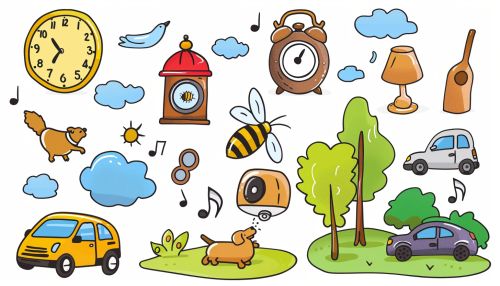Onomatopoeia
Overview
Onomatopoeia refers to the process of creating a word that phonetically imitates, resembles, or suggests the sound that it describes. Such a word itself is also called an onomatopoeia. Common onomatopoeias include animal noises such as "oink", "meow" (cats), "roar" (lions), and "chirp" (birds). Onomatopoeia is a common linguistic phenomenon in many world languages, and it is widely used in literature, especially in poetry and children's books.


Etymology
The term "onomatopoeia" originates from the Greek ονοματοποιία, which is a compound of ονοματο-, "onoma" (name) and -ποιία, "-poia" (making), meaning "name-making". It is a blend of sound and meaning, where the phonetic resemblance of the word to the sound it denotes is used as a method of naming or symbolizing the sound.
Types of Onomatopoeia
Onomatopoeia can be categorized into several types, including:
Direct Onomatopoeia
Direct onomatopoeia is a sound imitation of the actual sound made. Examples include "buzz", "hiss", "clang", and "pop".
Associative Onomatopoeia
Associative onomatopoeia involves words that do not imitate sounds but suggest the source's qualities. For instance, "whisper" does not sound like a whisper, but it is used to suggest a quiet, hushed sound.
Echoic Onomatopoeia
Echoic onomatopoeia refers to words that mimic the natural sounds of objects or animals. Examples include "cuckoo", "sizzle", "crash", and "murmur".
Use in Languages
Onomatopoeia is used in many languages, with variations in the specific sounds that are used. Here are some examples:
English
In English, onomatopoeia is used in many contexts, such as animal sounds (e.g., "moo", "quack", "meow"), human sounds (e.g., "giggle", "whisper", "groan"), and mechanical sounds (e.g., "click", "bang", "beep").
Japanese
Japanese is known for its extensive use of onomatopoeic expressions. In addition to animal sounds, Japanese onomatopoeia includes words that represent feelings, personal conditions, and other concepts. For example, "ぴかぴか (pika-pika)" represents the sound of sparkle, and "ぐっすり (gussuri)" represents the sound of deep sleep.
Spanish
In Spanish, onomatopoeic words are often used to describe sounds related to actions, emotions, and objects. For example, "tictac" is the sound of a clock, and "zumbido" is the sound of a buzz.
Use in Literature
Onomatopoeia is frequently employed in literature, particularly in poetry and children's literature, to add auditory imagery to the text. It can also be used to create a particular mood or tone, to mimic the sounds of nature, or to add a sense of realism to a scene.
Poetry
In poetry, onomatopoeia can be used to convey emotion, set a rhythm, and enhance imagery. For example, Edgar Allan Poe's "The Bells" uses onomatopoeia to mimic the sounds of the bells and create a rhythmic effect.
Children's Literature
In children's literature, onomatopoeia is often used to engage young readers and help them connect the sounds of words with their meanings. Books like "Mr. Brown Can Moo, Can You?" by Dr. Seuss use onomatopoeia to teach children about sounds and language.
